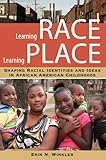Learning Race, Learning Place : Shaping Racial Identities and Ideas in African American Childhoods / Erin N. Winkler.
Material type: TextSeries: Rutgers Series in Childhood StudiesPublisher: New Brunswick, NJ : Rutgers University Press, [2012]Copyright date: ©2012Description: 1 online resource (230 p.) : 7 figures, 1 mapContent type:
TextSeries: Rutgers Series in Childhood StudiesPublisher: New Brunswick, NJ : Rutgers University Press, [2012]Copyright date: ©2012Description: 1 online resource (230 p.) : 7 figures, 1 mapContent type: - 9780813554303
- 9780813554310
- online - DeGruyter
| Item type | Current library | Call number | URL | Status | Notes | Barcode | |
|---|---|---|---|---|---|---|---|
 eBook
eBook
|
Biblioteca "Angelicum" Pont. Univ. S.Tommaso d'Aquino Nuvola online | online - DeGruyter (Browse shelf(Opens below)) | Online access | Not for loan (Accesso limitato) | Accesso per gli utenti autorizzati / Access for authorized users | (dgr)9780813554310 |
Browsing Biblioteca "Angelicum" Pont. Univ. S.Tommaso d'Aquino shelves, Shelving location: Nuvola online Close shelf browser (Hides shelf browser)

|

|

|

|

|

|

|
||
| online - DeGruyter New Jersey : A History of the Garden State / | online - DeGruyter Compassionate Confinement : A Year in the Life of Unit C / | online - DeGruyter Sustaining Cities : Urban Policies, Practices, and Perceptions / | online - DeGruyter Learning Race, Learning Place : Shaping Racial Identities and Ideas in African American Childhoods / | online - DeGruyter Abandoning the Black Hero : Sympathy and Privacy in the Postwar African American White-Life Novel / | online - DeGruyter Haskalah : The Romantic Movement in Judaism / | online - DeGruyter The Case That Never Dies : The Lindbergh Kidnapping / |
Frontmatter -- CONTENTS -- ILLUSTRATIONS -- ACKNOWLEDGMENTS -- 1. Comprehensive Racial Learning, Grounded in Place -- 2. Rhetoric versus Reality: Ambivalence about Race and Racism -- 3. Racialized Place: Comprehensive Racial Learning through Travel -- 4. Place Matters: Shaping Mothers’ Messages -- 5. Competing with Society: Responsive Racial Socialization -- 6. Black Is Black? Gender, Skin Tone, and Comprehensive Racial Learning -- 7. Conclusion: “I Learn Being Black from Everywhere I Go” -- NOTES -- REFERENCES -- INDEX
restricted access online access with authorization star
http://purl.org/coar/access_right/c_16ec
In an American society both increasingly diverse and increasingly segregated, the signals children receive about race are more confusing than ever. In this context, how do children negotiate and make meaning of multiple and conflicting messages to develop their own ideas about race? Learning Race, Learning Place engages this question using in-depth interviews with an economically diverse group of African American children and their mothers. Through these rich narratives, Erin N. Winkler seeks to reorient the way we look at how children develop their ideas about race through the introduction of a new framework—comprehensive racial learning—that shows the importance of considering this process from children’s points of view and listening to their interpretations of their experiences, which are often quite different from what the adults around them expect or intend. At the children’s prompting, Winkler examines the roles of multiple actors and influences, including gender, skin tone, colorblind rhetoric, peers, family, media, school, and, especially, place. She brings to the fore the complex and understudied power of place, positing that while children’s racial identities and experiences are shaped by a national construction of race, they are also specific to a particular place that exerts both direct and indirect influence on their racial identities and ideas.
Mode of access: Internet via World Wide Web.
In English.
Description based on online resource; title from PDF title page (publisher's Web site, viewed 27. Jan 2023)


